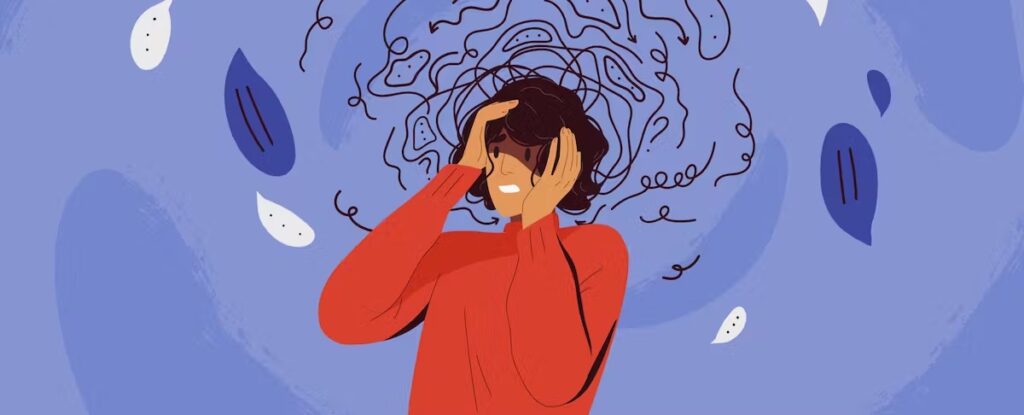How to process trauma

Here we will share the experience we have gained about how to process trauma. The experiences stem from our own healing processes, from courses and education and from many years of experience in guiding others in precisely how to process trauma.
There is no concrete recipe for processing trauma that suits everyone. Various models have been developed.
Here we will reproduce what we consider to be the most basic and simplest method. The principles we present here have universal value.
How to process trauma - a summary
We begin with a summary of some important principles for processing trauma before going into more detail.
How to process trauma:
- Trust your own organism
- Learn how to control your body and mind
- Learn to regulate your nervous system
- Expose yourself to triggers
- Regulate anxiety, let go of control and follow the body's natural reactions
So what do we mean by all this?
Simply put, you just need to understand a little more about how the body works, become aware of patterns of avoidance and overcontrol, learn to calm the body down, consciously seek out what you are avoiding and let the body react rather than understand with the head.
These are not complicated principles at all. It can still be a demanding process. Most of us are more than willing to go through a demanding process - if we believe that it will actually help us.
Hopefully the article will help you see a way forward. What steps you need to take to move forward. As long as you notice that it is moving forward, it doesn't matter that much that it takes some time.
The organism wants you well
Our organism has evolved over millions of years. It knows exactly how to process trauma. It is inherent that our bodies try to react to what they are going through.
Animals that are properly frightened physically shake it off before moving on. Children in bomb shelters sit and tremble.
The problem for adults is that we do not allow the body's natural reactions to violent events.
Often the ability to over-control our emotions was necessary. If we cried, screamed or showed that we were afraid in the original traumatic situation, it might make the pain worse.
But if we have never reacted physically to what has happened, the body will keep the accounts. Every time we are triggered we will develop symptoms. Various forms of anxiety and pain are the most common.
Because our bodies need to react.
But we are frightened when uncontrolled bodily reactions begin to build up in us. Reactions we don't fully understand. We are quick to be intimidated by them and judge them as inappropriate and suppress them.
Our egos get in the way. We lack a basic trust in our own organism. But it knows how to process trauma. We have to learn to let it go.
Trauma is processed through the body
The way we react to our own bodily reactions is shaped by the cultural framework for what are somehow acceptable emotional expressions.
The word emotion means to move. And it is in language that we are "moved" by something.
If we are moved by something beautiful or sad, we can get tears in our eyes. Some tolerate it well, while others are stressed by even such a subtle expression, bite their lip and wipe away their tears as quickly as possible.
After a violent event, it is natural that the body will react violently. But what happens now that culture has put such strong bonds on our expressions?
And when we learned that we had to be careful to show our vulnerability, or show our protest?
When a panic attack comes, and one is not frightened by it, but trusts in it, it will like to be transformed into a redemptive emotional reaction. Often sobbing.
Who among us dares to let go of control over the body? To actually let the body move from the depths, rather than being the one controlling the body movements?
It takes courage. But you can trust your own depth.
Into and through the discomfort
Rumbling anxiety in the stomach, or pressure over the chest are likewise signs of an emotional energy in the body that is stopped and held back.
Completely unconscious, completely automated. The solution is to learn to let go, and let the body react.
One technique for working with bodily discomfort is to imagine the discomfort as embers in a fire. Imagine that every time you take a breath, oxygen is supplied allowing the embers to flare up a little.
One cannot control the fire. It will come when it comes. And it goes out when it goes out. Cultivate a similar attitude toward the bodily reactions that lie in wait.
Another technique is to simply breathe and notice the discomfort. Try to feel the discomfort as clearly as possible. If you were to give the body sensation a form, what would it be like? A colour? A texture?
Add more to any changes and movements and follow them as they come.
The point is not to avoid or try to get rid of the discomfort. Nor push a reaction forward. But wait for the weather and wait for the body.
It is not you who must heal body and mind. Learn to step aside, and let your body and mind heal you. When the organism is ready for it.
When the body is ready for it, it will start to react. At first, we will still be able to be intimidated. A little of the primal, natural feeling comes out, but the rest is stopped by anxiety and avoidance.
Often we need time before we are able to feel an emotion fully, without being frightened or judging it and being ashamed at the same time.
Control mechanisms that prevent processing
When one begins work on inviting one's own emotional reactions to traumatic events, apparently not much happens initially. Why?
The learned and automated ways of keeping the emotional reactions at bay will continue to prevent processing of the trauma. In this phase you learn about what is happening instead of the trauma reactions coming.
It is normal to think and ponder. Some may become self-critical. Impatient. Judging. Stated. You may think that you can't do it. That it is useless.
All of these can be seen as defense mechanisms. When you go to these positions, you are no longer open, receptive and receptive to signals from the body. We get stuck in mental landscapes instead.
It is not a problem that such mechanisms appear. On the contrary, we learn how to deal with difficult emotions. How we meet ourselves.
Was a solution to your difficulties to start criticizing yourself instead of the environment? Was giving up easier, and perhaps even more rational, than trying to try?
Every time we start to think, ponder, judge etc, we can kindly turn our attention back to the body sensations we may have.
We try to put the gear in "neutral". So that we don't get in the way with mental and physical overcontrol.
Self-regulation – a crucial tool for processing trauma
When we begin such work toward exposing ourselves to inner sensations that we normally avoid, and suspending our defenses, most of us will at one time or another experience being overwhelmed.
We have thresholds for how much of the underlying emotional reactions we can tolerate processing. You may notice this in the form of a feeling of unreality, dizziness or light-headedness, ringing in the ears or blurred (side) vision. You kind of just slide further away from yourself. You are not fully present. Then the system is in a kind of game-death mode.
Then we must learn to take breaks from work, and actively regulate our own nervous system.
In other cases, it may be that as an emotional reaction is about to break through, we become frightened and try to flee. Despondent tears press on and the fear that you will fall into a black hole and never come back up takes over.
It can also feel overwhelming, but without the body actually disconnecting, or dissociating, as we have described above.
Then it may be sufficient to notice that the body becomes afraid, the automaticity that then lies in connecting to despair or hopelessness or whatever it may be, and bring the attention back to the more primary bodily sensations.
Think of it as an emotional workout. When you can't lift the weight one more time, there's no point in pushing further. Then we put it down, shake it loose and rest. Before we are ready for another round.
One could think of a trauma problem as a kind of phobia. Most people know that to cure spider phobia one must gradually approach the spider.
Go to the threshold for anxiety to become overwhelming. Try to stay there long enough for the anxiety to begin to subside. Use techniques that help you calm down the body (see further down in the article). Take a step back if necessary.
The same principle applies to how to process trauma. We must gradually approach the emotional reactions the trauma gave. Gradually approach the parts of ourselves that we had to distance ourselves from.
We must gradually reclaim ourselves. And integrate all the parts we are made of, all the needs, all the feelings.
This is how we can become who we were always meant to be.
How to regulate the nervous system
One technique for regulating one's own anxiety when it has become too high is simply to take an observing distance from what is happening. You have a body, a biological machine, a kind of monkey suit that has its own programming.
Some buttons have been pressed which make the body remember, and the alarm goes off. Easily.
At the same time, you have an awareness. Another part of you, something that is more you than your bodily reactions, that can observe what is happening to the body.
Go to the conscious observer you have to the inside. Learn to turn it on and let it map exactly what's happening to your body. Taking such an observing distance, where one observes what is happening in a matter-of-factly manner, has an anxiety-relieving function.
A related technique is so-called "priming". Your body is overwhelmed by a trauma trigger. The trauma is over. Remind yourself that your body is here and now. In another room, in another time. Plant your feet on the ground.
Sit up in the chair. Stretch yourself. Look around, get in touch with what is happening here and now in the room. Count objects - anything to get a bit out of the inner scary world, and into the safer outer one.
Another effective way to regulate the nervous system is through deep, slow breathing.
Finally, actively engaging in thinking and analysis, rather than leaning into body sensations, can contribute to regulation.
There are also other techniques. Learn some that work for you.
Emotional reactions provide insight
When an undisturbed, pure feeling eventually gets through, it always gives a deep and long-awaited relaxation afterward.
What we also see is that from this relaxed, safe position, mental information automatically flows up. We get access to information about what happened that we have blocked. Not always, but often.
We may notice a forgotten aspect of the situation. Perhaps we remember that we actually tried to resist. Or we really open our eyes to how small we were when it happened. How paralyzed we were.
This is an important part of the healing process. These pieces of information are important pieces of the puzzle. They change the story we have made about what happened.
What's more: Too often we work too hard trying to understand "top-down" from the head. What is happening in my body? Why do I have anxiety or this and that reaction?
We can go on spinning and pondering in ever new rounds, but we don't get off the mark.
We are then looking in the parts of the mind that are already enlightened, not those that lie in the dark - below the threshold of consciousness. The problems do not come from the rational plane, but from the emotional one.
Therefore, we also have to solve them on the emotional level. From the body. Bottom-up.
An important assessment criterion for whether you have let a pure feeling through, or whether you ended up in a mixed state where some primary feelings came up, some anxiety came up and, for example, some more defensive tears, is whether you feel relaxed, clearer and calmer in your body afterwards .
Bringing up "feelings", which are actually a mixture of feelings, anxiety about the feeling and defense against it, is something different than the body actually gaining access to pure sadness, pure anger, pure (and healthy) guilt or the like.
What is a healing process?
A healing process is primarily a process where you gradually learn to regain trust in your own organism. That the organism wants you well in its expressions.
As you know, healing is a process. It is not linear, but rather circular. You need some tools, but above all a specific attitude that can assist in this process.
The doctor does not heal a wound. He removes barriers and creates optimal conditions for your body to heal itself. The idea that a therapist, your ego or a medicine will heal you is simply wrong.
You, a therapist and a drug can, like the doctor, remove barriers and create favorable conditions for the body and mind to heal themselves.
It's about getting our ego out of the way. Learn how to trust your own psyche - to trust nature.
Too often we try to solve our problems from our heads or by trying to force our symptoms to change. What is needed is to reach, and heal, the underlying wound.
And the visceral experience of the repressed emotions associated with this wound.
The good news is that repressed emotions will always try to express themselves. There is an innate spontaneous tendency to heal even mental wounds.
No more than you can figure out how to heal a broken bone, you can't figure out how to heal from a mental wound.
The good news is that your organism knows and wants to help you with this - all the time! If you're just getting out of the way, give the deeper layers of you some space. We must learn to listen inwardly.
Understand the dynamics of the psyche
We will now explain a little more clearly what leads to what in the psyche. That is, the order of things.
The challenge with inward listening is that when unconscious repressed emotions are close to the surface, they will create unconscious anxiety.
This anxiety will drive unconscious defensive behavior (mostly muscle contractions and mental strategies where our attention is drawn elsewhere, and so-called defensive emotions (such as irritation with oneself, despair, hopelessness, helplessness).
In this context, depression can be regarded as a defence, with mental and physical de-pressing" of underlying unconscious feelings.
Depression can also be understood as an adaptive adaptation in a situation where there is no point in continuing to try anyway. Where you are faced with an opposing force against which you have no chance.
Obsessions and compulsions can also be considered defenses. And there's nothing inherently wrong with that, it's just one of the ways we can try and deal with difficult emotions. But at a high price.
Learning to observe the causal dynamics of your psyche is an important key. Becoming aware of the triggers, anxiety and defenses that come up.
This can be challenging. But it gives us an opportunity to build our tolerance for anxiety, block our defenses and make room for our organism to finally respond to what it has been through.
It heals us. When we allow our organism to be moved by our emotions, this also opens the mind, memories, insights and the puzzle finally falls into place.
The story you have told yourself is changing.
Basic prerequisites for processing trauma
To face this often painful truth, we must feel a certain degree of compassion and trust. If not, the psyche will protect itself from going there. It takes time to develop trust in a relationship. And to himself.
It can take time to be able to take in compassion from others. And give it to yourself.
The psyche is like an onion, we travel inwards through ever new layers.
If you feel that your body is grumbling, and you lie down and try to process the underlying feelings, it is not certain that much will "happen" in the first place. Perhaps you have struggled with some of the outer layers.
It is okay! What can be learned? What might have blocked you from going deeper? It is more important to learn about what is blocking you right now, than to reach an assumed future state.
You can't rush your healing. The more you push – the more you push back.
Flight instructions for trauma processing
When trying to process trauma, don't try to fight, grab, do something, just flow down. Breathe. Put on music and listen to it. Let it carry you. Observe. Awareness of the present. When you accept what is, what is changes.
What you resist, persists.
Also remember, there is nothing for you to solve. It is as impossible to solve your problems as it is to understand time. Probably because both are illusions. Nature is not a problem
Because we humans are an expression of nature. We go way back. How could there be something inherently wrong with us? We are sure that the symptoms you describe are completely natural expressions of some aspect of nature.
How can it not be?
This is important. How could we have become so obsessed with our ego identities, so disconnected from the fact that we are expressions of nature?
As the philosopher Allan Watts puts it: We did not enter this world, we grew out of it.
The problem is that at some point an illusion was created that something is wrong with us. With you and with me and with everyone. The culture we live in, combined with more or less obvious trauma in our family, can make it difficult to accept our nature.
When we begin to repress parts of ourselves, we develop symptoms. Since children depend on the bond of caregivers, they will always sacrifice their own authenticity for attachment if it boils down to that.
Just because your reactions are natural, doesn't mean they can't be destructive to yourself and those around you. That doesn't mean everything you do is okay. Of course.
But there is no reason to resort to personal shame or guilt. It is often just an obstacle to fully recognizing the destructiveness of your reaction patterns.
You have to recognize that you have a wound that you may be carrying on, you too. You have been programmed and need deprogramming. You carry a pain that needs to be expressed in a much more direct way.
We cannot force ourselves to change. We must heal the underlying wound. We must face ourselves with understanding and tenderness.
What we judge we cannot understand. While what we understand, we cannot judge.
When we judge ourselves or others, it is because we do not understand.
Process the trauma of the inner child
The fact that you have symptoms is not a problem. Symptoms are messengers. They want to tell something. They are signs that something is trying to be seen and integrated.
A symptom is something that is half outside, half stuck inside.
It is also not a problem that you encounter triggers. A trigger is an opportunity for healing.
It is said that trauma runs in families - until someone is able to actually feel it.
Let that someone be you.
To do that, you need to cultivate a set of attitudes towards your own process. An image that can be helpful is the idea that it is the child inside you who needs healing.
It was most often when we were small that the basis for our problems was created.
It can be difficult not to judge yourself as an adult. But easier if you imagine yourself as a child. Learn to meet yourself as a good parent would. How is it?
Take for granted that there is a good reason for your child's expression, even if you may not fully understand it right away.
Don't fall for the temptation to judge, rush, push. If you do, say you're sorry. Meet yourself with moment-to-moment attention, curiosity, understanding, patience, gentleness.
It takes time for a wounded child to open up. Because of fear and lack of trust. But it will eventually open up. When it senses that the danger is over, and there is compassion to be found.
It must learn to trust others and itself again. It needs to regulate anxiety in other ways than through distractions. The organism needs to learn to relax deep within itself again.
Process trauma on your own?
Most of us need assistance in a process of processing trauma. But an important part of the work is done outside the therapy office.
The therapists at the trauma center will help you understand more of how you can process trauma on your own. They will be able to provide sufficient trust and compassion for you to be ready to confront the often painful truth about everything that has happened and not least how it has actually been for you.
We wish you all the best.
We will end with a poem by Helge Torvund:
The light
you need
exists








